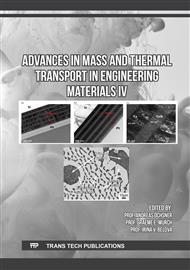p.152
p.162
p.171
p.179
p.191
p.209
p.219
p.229
p.239
Cooling Effect on Nano Eutectoid Phase Formation of Hypereutectic Zn-Al Alloy
Abstract:
To understand the nano phase formation, cooling experiments of a hypereutectic Zn-Al alloy containing 6 wt% of Al are carried out under two different cooling rates of 0.04 and 10.00 °C/s. The applied cooling rates significantly influence the phase change behavior of the investigated alloy. The liquidus temperature (TN) for the nucleation of the primary phase decreases from 390.3 to 382.9 °C, and the undercooling increases from 0.7 to 8.1 °C, as the cooling rate rises from 0.04 to 10 °C/s. The eutectic and eutectoid temperatures decrease from 381.5, 277.7 to 375.6 and 267.6 °C, respectively, when the cooling rate increases from 0.04 to 10.00 °C/s. The SEM and EDS analyses reveal that the solidified alloy contains the primary γ-ZnAl phase, the eutectic β-Zn phase, and the eutectoid α-Al and eutectoid β-Zn phases. The fast phase change and transformation caused by rapid cooling results in the formation of nano eutectoid phases and fine microstructure.
Info:
Periodical:
Pages:
209-218
Citation:
Online since:
December 2023
Authors:
Keywords:
Price:
Сopyright:
© 2023 Trans Tech Publications Ltd. All Rights Reserved
Share:
Citation:


